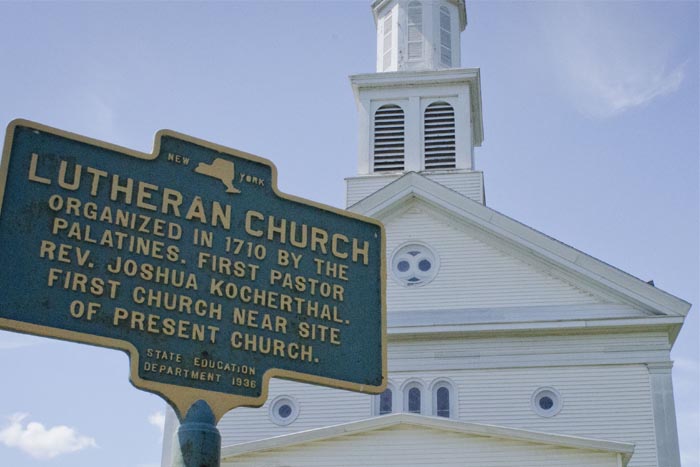
After a hiatus of six years, the Saugerties Historic House Tour is back. Two bus tours, each carrying a guide, will be available on Saturday, May 19: a morning excursion leaving Saugerties High School at 9 a.m. and an afternoon tour leaving from the same location at 1 p.m. Each tour will last approximately three hours.
The tours are sponsored by the Town of Saugerties Historic Preservation Commission, and they will focus on the northern quadrant of Saugerties, where tourgoers will learn about the area’s historic connection with the Palatine immigrants of 1710, who established a community in West Camp.
Some members of that original community moved west, reaching central New York and northern Pennsylvania, but others stayed in Saugerties, particularly in the Asbury area. Earlier this year, the Town of Saugerties Historic Preservation Commission began the process of designating the Asbury settlement as a historic rural landscape district – a first for Saugerties, according to Preservation Commission member Susan Puretz. “We have individual houses registered as historic,” she says, “but this is the first district.” The designation will include the Trumpbour Homestead (a National and State Historic Register landmark) along with several stone houses, two Colonial roadbeds, a Methodist cemetery of national significance and archaeological sites of lost settlement areas recorded on old surveys.
The bus-tour route will offer views of some of the 68 stone houses in Asbury, Saxton and Blue Mountain. In addition to the Palatines, the influence of the English, German and Dutch settlers is also found in the northern quadrant. While there are many similarities in construction techniques of the various groups of settlers, there are also notable differences. The guide on each bus will point out interesting details on the drive, and an informative brochure will be provided with route descriptions as well as useful architectural and historic facts.
The bus will stop to explore the interiors of three of these stone houses, which date from the late 1700s to the early 1800s. The first house, says Puretz, is an elegant home that was built on land farmed by one of the original Palatines. House two is a working farm, in the owners’ family for many generations. The third house, where the tour concludes, is an example of a “bank house,” built into the side of a bank. “You enter downstairs,” Puretz explains. “If you look at it from one side, you only see the top floor, but on the other side, you can see it’s actually two-and-a-half stories.”
Complimentary refreshments will be served at the third house, whose owner is also on the Preservation Commission committee organizing the tour. In a fun twist on the historic theme for the day, she will offer refreshments of a type that would have been served in the era when the house was built.
Tickets for the Saugerties Historic House Tour cost $20, and are available online only at https://housetour.brownpapertickets.com. A service fee is charged, making the end cost $21.69 per ticket. Seating is limited, making early purchase advisable.
Saugerties Historic House Tour, Saturday, May 19, 9 a.m./1 p.m., $21.69 online only, departs from Saugerties High School, 310 Washington Avenue, Saugerties; www.facebook.com/historichousebustour, www.historichousetour.com. The schoolbuses used for the tour do not have a restroom, but bathroom facilities will be available at the beginning and end of the tour (at the high school departure and the tour ending opposite Cantine Field), and a porta-potty will be set up outside the second stone house on the tour.

The Palatines are German. Rhinelanders. The names like Shultis which I’d thought was Dutch is German! Same as Schultz etc.
https://en.wikipedia.org/wiki/German_Palatines
Migration to New York[edit]
Germans had trickled into North American colonies since their earliest days. The first mass migration, however, began in 1708. Queen Anne’s government had sympathy for the Protestant Germans and had invited them to go to the colonies and work in trade for passage. Official correspondence in British records shows a combined total of 13,146 refugees traveled down the Rhine and or from Amsterdam to England in the summer of 1709.[16] More than 3500 of these were returned from England either because they were Roman Catholic or at their own request.[17] Henry Jones, quotes an entry in a churchbook by the Pastor of Dreieichenhain that states a total of 15,313 Germans left their villages in 1709 “for the so-called New America and, of course, Carolina.” [18] The flood of immigration overwhelmed English resources. It resulted in major disruptions, overcrowding, famine, disease and the death of a thousand or more Palatines. It appeared the entire Palatinate would be emptied before a halt could be called to emigration.[19] Many reasons have been given to explain why so many families left their homes for an unknown land. Knittle summarizes them: “(1) war devastation, (2) heavy taxation, (3) an extraordinarily severe winter, (4) religious quarrels, but not persecutions, (5) land hunger on the part of the elderly and desire for adventure on the part of the young, (6) liberal advertising by colonial proprietors, and finally (7) the benevolent and active cooperation of the British government.” [20]
No doubt the biggest impetus was the harsh, cold winter that preceded their departure.
Yes, many of my family members were Palatines that settled in Saugerties, HOFF was one of them.